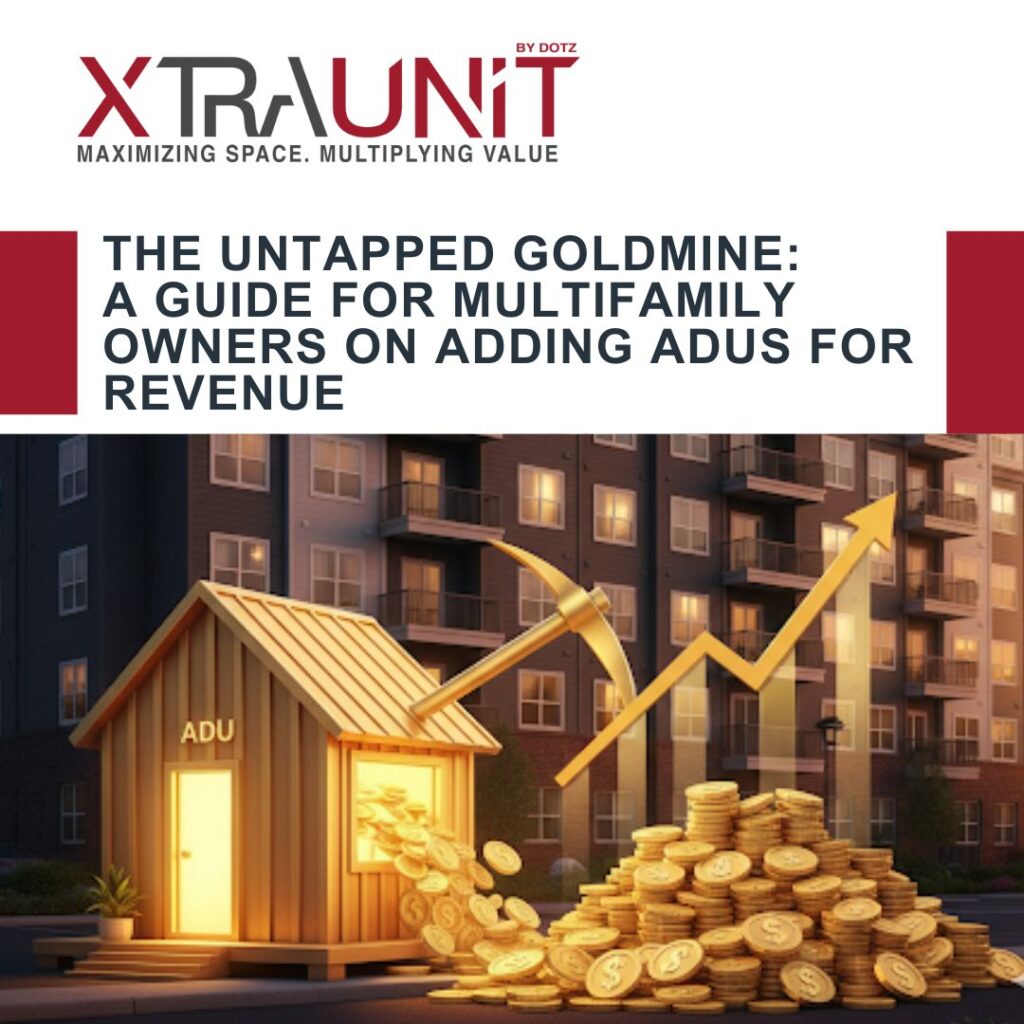The Untapped Goldmine: A Guide for Multifamily Owners on Adding ADUs for Revenue

As a multifamily property owner in California, you are constantly looking for ways to enhance your asset’s performance. You’ve likely focused on renovations, rent optimization, and operational efficiencies. But what if your property holds a significant, untapped source of revenue hidden in plain sight?
Thanks to recent, game-changing state laws, that source is now accessible. The addition of Accessory Dwelling Units (ADUs) to existing apartment buildings represents one of the most powerful value-add opportunities in the current real estate market. It’s a chance to significantly increase your monthly cash flow and boost your property’s valuation.
At Xtraunit, we specialize in helping property owners unlock this hidden potential. This guide will walk you through how it works.
The New Math of Density: More Doors, More Revenue
For decades, your property’s unit count was fixed by its original zoning. That has changed. Under California Government Code § 66314 (c), ADUs are not counted towards the property’s density limit.
This is a critical distinction. It means that even if your lot is technically “maxed out,” you now have a legal, streamlined path to add new, rent-generating units. You are no longer limited by the old rules.
The financial impact is twofold and immediate:
- Increased Gross Potential Rent: Every ADU added is a new stream of monthly income, directly boosting your top-line revenue.
- Forced Appreciation: Your property’s value is largely determined by its Net Operating Income (NOI). By adding units and increasing your rent roll with minimal impact on operating expenses, you directly force the appreciation of your asset.
Your Path to More Units: Key ADU Strategies
California law provides two primary pathways for adding ADUs to existing multifamily properties. The right strategy depends on your property’s physical layout and your investment goals.
1. Detached ADUs: Building New Units in Open Space
(Governed by Senate Bill 1211)
This strategy is perfect for properties with underutilized open space, such as large backyards, side yards, or excess surface parking. It allows for the construction of brand-new, standalone rental units.
- The Potential: You can add the same number of ADUs as there are existing units on the lot, up to a maximum of eight new detached ADUs.
- The Method: These units can be newly constructed from the ground up or created by converting an existing detached structure, like a multi-car garage.
- The Rules: While these units must adhere to standard setback and floor area rules, local agencies can only limit them to 800 sq ft, and many cities like Los Angeles are more permissive, allowing for larger footprints.
2. Attached ADUs: Monetizing Underutilized Interior Space
(Governed by Gov. Code, § 66323, subd. (a)(3)(A))
This strategy allows you to convert existing non-livable space within your apartment building into new, rentable units. This is an incredibly efficient way to add value by transforming spaces that currently produce zero income.
- The Potential: You can add a minimum of one attached ADU, or up to 25% of the existing number of units, whichever is greater. For a 20-unit building, that means up to five new units.
- The Method: This powerful option is primarily for converting existing non-livable space, such as storage rooms, boiler rooms, underused recreation rooms, or laundry facilities.
- The Nuance: While new construction of attached ADUs is generally limited, a critical local exception exists. The City of Los Angeles allows for one newly constructed attached ADU under LAMC 12.22 A.33 (c) and (e)—a nuance our team expertly navigates to maximize your unit count.
Overcoming the Biggest Hurdle: Parking Requirements
For most developers, the word “parking” triggers concerns about cost and feasibility. However, the state has made adding ADUs incredibly attractive by drastically reducing or eliminating parking requirements.
- The Law: Under Gov. Code, § 66314, subd. (d)(10)(A), the absolute maximum parking required is one space per new ADU, and tandem parking is acceptable.
- The Exemption: This requirement is completely waived for properties located within a one-half mile walking distance of a major transit stop (e.g., a rail station or a high-frequency bus line). A huge portion of Los Angeles falls into this category, meaning most multifamily properties can add ADUs with zero new parking spaces required.
The Xtraunit Advantage: Your Expert Partner
Navigating the web of state and local ADU regulations is complex. Successfully executing one of these projects requires a partner who understands the process from every angle.
Xtraunit provides a true turnkey solution. We begin with a comprehensive Feasibility Study of your property to determine the optimal strategy. Our in-house design team then produces a fully coordinated set of plans engineered for cost-effective construction. We manage the entire entitlement process with LADBS and, once approved, our construction crews execute the build with precision and efficiency.
Stop Leaving Money on the Table
The laws are in place. The opportunity is real. Don’t let your property’s potential lie dormant.
Contact us for a professional analysis. Let the experts at Xtraunit show you how many units you can add to your property and what the return on your investment could be.
